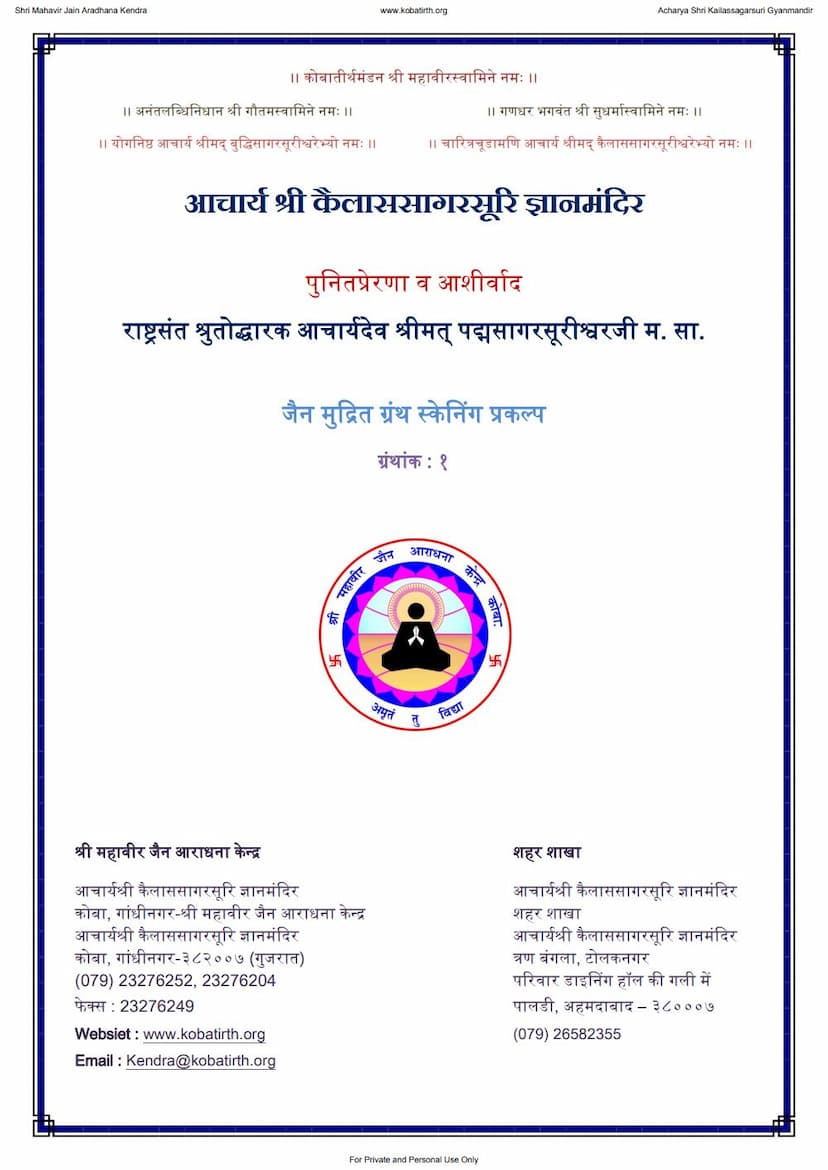Agam 21 Upang 10 Pushpika Sutra Shwetambar
Added to library: September 1, 2025

Summary
This document is a scanned copy of the Pushpika Sutra, the tenth Upanga in the Shwetambar Jain Agamas. The entire document is in Gujarati, with some Sanskrit terms interspersed. It is part of a larger project to scan and preserve Jain scriptures, under the guidance of Acharya Shri Kailassagarsuri Gyanmandir.
Here's a breakdown of the content:
Front Matter and Introduction (Pages 1-10):
- Publisher and Patronage: The document begins with acknowledgments and details of the Shri Mahavir Jain Aradhana Kendra, specifically the Acharya Shri Kailassagarsuri Gyanmandir, and its various branches. It highlights the patronage of prominent Jain Acharyas, including Acharya Shri Anandasagarsurishwarji Maharaj, who revised and edited 45 Agamas.
- The Text's Origin and Purpose: The Pushpika Sutra is presented as the tenth Upanga, attributed to the Shwetambar tradition. The introductory pages emphasize the importance of Shrutagnan (knowledge obtained through listening and scriptures) as the guiding light for beings in the cycle of birth and death.
- History of Agam Recensions (Vachanas): A significant portion of the introductory pages (pages 6-10) delves into the historical recensions (Vachanas) of the Jain Agamas. It details six major recensions that occurred over a period of 1000 years after Lord Mahavir's nirvana.
- First Vachana (Shri Dvadashangashrutasangrahan): Occurred around 160 years after nirvana in Pataliputra, under the presidency of Sthulabhadra, to compile the twelve Angas after a period of famine and dispersal of monks.
- Second Vachana (Agam Samrakshan Vachana): During the reign of King Samprati in Ujjain, around 245-281 years after nirvana, to address deficiencies in recitation and teaching.
- Third Vachana: Between 300-330 years after nirvana, following persecution by Pushyamitra, a compilation of eleven Angas and ten Purvas was attempted in Kalinga.
- Fourth Vachana: Around 192 years after nirvana in Dashpur, by Vajraswami, to arrange the Agamas in line with the reduced capacities of the monks due to a severe famine.
- Fifth Vachana: Around 830-840 years after nirvana, in Mathura and Valabhi, to compile Agamas in different regions due to political instability.
- Sixth Vachana: The most significant one, at Valabhi, by Acharya Devardhigani Kshamashramana and Acharya Kalak Suri, where the 84 Agamas were systematically compiled and inscribed on palm leaves, marking the scripturalization of the Agamas.
- The Importance of Acharya Anandasagarsurishwarji: The introduction highlights the crucial role of Acharya Anandasagarsurishwarji Maharaj in reprinting these Agamas and his efforts in reviving the tradition of communal recitations. It also mentions the significant contribution of Munishri Punyavijayji in this endeavor.
The Pushpika Sutra Text (Pages 12-37):
-
Content of the Sutra: The core of the document contains the Pushpika Sutra itself. The sutra is presented in a question-and-answer format between Lord Gautama (Bhagwan Goyame) and Lord Mahavir (Bhagwan Mahavir).
-
Chapter Breakdown: The sutra appears to be divided into chapters (adhyayana), with the following being presented:
- First Chapter (Chande Adhyayana): Discusses the celestial being named Chandra, a Jovishthinda (lord of stars/planets). It recounts his past life as Angati, a wealthy householder who became a monk, attained purification, and was reborn as Chandra. It also details his lifespan and future liberation. (Pages 12-14)
- Second Chapter (Surye Adhyayana): Continues the narrative style, describing the celestial being Surya, and his past life as Supathite, a householder who became a monk and later attained rebirth. (Pages 14-15)
- Third Chapter (Shukre Adhyayana): Details the celestial being Shukra, and his past life as Somila, a Brahmin who renounced worldly life, became an ascetic, and eventually attained rebirth in the Shukra celestial realm. The narrative of Somila's ascetic practices and the guidance he received from gods and his own reflections are vividly described. (Pages 15-22)
- Fourth Chapter (Bahupautriya Adhyayana): Focuses on the celestial being Bahupautriya Devi, and her past life as Subhadra, the wife of a merchant named Bhadra. The narrative highlights her desire for children, her interaction with Jain nuns (Arya), her renunciation and eventual rebirth in the Bahupautriya celestial realm. It also details her lifespan and future liberation. (Pages 22-30)
- Fifth Chapter (Purnabhadra Adhyayana): Describes the celestial being Purnabhadra, and his past life as Purnabhadra, a householder who became a monk, attained purification, and was reborn as Purnabhadra. (Pages 33-34)
- Sixth Chapter (Manibhadra Adhyayana): Details the celestial being Manibhadra, and his past life as Manibhadra, a householder who renounced the world and attained liberation. (Pages 34-35)
- The text also briefly mentions other celestial beings like Datta, Shive, and Balavati, stating they follow a similar pattern of narration as Purnabhadra. (Page 35)
-
Structure of the Narrative: The sutra primarily uses the narrative format to explain the past lives (Purvabhava) of celestial beings. These past lives often involve characters who, after experiencing worldly pleasures or hardships, turn to asceticism, practice austerities, and ultimately attain heavenly rebirths or liberation.
Overall Purpose:
The Pushpika Sutra, as presented in this scanned document, aims to illustrate the principles of Jainism through the stories of individuals who undergo various stages of spiritual development. It emphasizes the importance of:
- Renunciation: The desire for spiritual liberation often arises from dissatisfaction with worldly pleasures.
- Asceticism: Strict adherence to austerities and vows is crucial for spiritual progress.
- Past Karma: Actions in past lives significantly influence present circumstances and future destinies.
- The Role of Acharyas and Munis: The guidance of enlightened spiritual leaders is essential for understanding the right path.
- Jain Cosmology: The text provides insights into the Jain understanding of celestial realms and the cycle of rebirth.
This document is a valuable resource for understanding the content of the Pushpika Sutra within the context of Jain scripture and its preservation efforts.